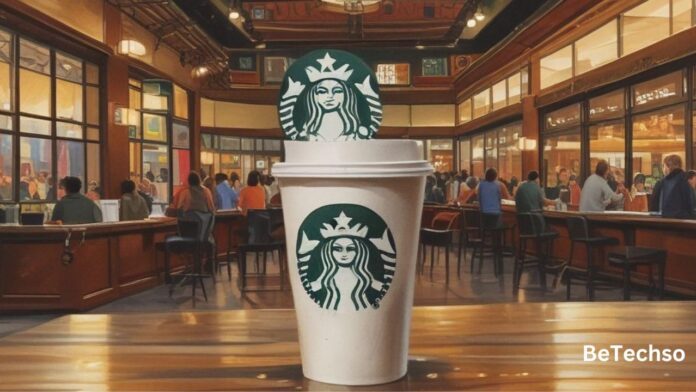Starbucks Coffee When Howard Schultz walked into a Starbucks store for the first time in 1982, he wasn’t just sampling the company’s coffee was stepping into a cultural revolution. What began as a small Seattle coffee bean retailer has transformed into an iconic global brand that has redefined how the world perceives coffee culture.
Starbucks is more than just a coffee shop; it is a symbol of social interaction, innovation, and community.
The Birth of a Coffee Empire
Starbucks Coffee started in 1971 in Seattle’s Pike Place Market, founded by Jerry Baldwin, Zev Siegl, and Gordon Official Website. Initially, the store sold high-quality coffee beans and equipment for brewing coffee at home. The company’s name, inspired by Herman Melville’s “Moby Dick,” reflected the maritime theme with the siren logo symbolizing the lure of coffee. However, the company’s big break came when Howard Schultz, then the director of retail operations, visited Italy. Schultz was captivated by the
Starbucks Coffee Inspired by this culture, Schultz envisioned a similar environment for Starbucks. After convincing the company’s founders to experiment with espresso drinks, Starbucks began transforming its stores into places where people could not only buy coffee but also experience a sense of community and connection. By 1992, Starbucks went public, and the company’s growth exploded, with new stores opening across the United States and eventually around the world.
A Global Phenomenon
Today, Starbucks operates over 35,000 stores in more than 80 countries. Its success can be attributed to several factors, including its commitment to quality, its unique store experience, and its ability to adapt to local cultures. Starbucks has not only popularized specialty coffee drinks like the Pumpkin Spice Latte and the Caramel Macchiato but has also become a platform for cultural exchange. In countries like China, Starbucks has embraced local flavors, offering drinks like the Matcha Latte and Dragon Dumplings, thereby integrating into the local fabric while maintaining its core identity.
The store design plays a crucial role in this global appeal. Starbucks locations are carefully curated to reflect local architecture and culture while maintaining the familiar aesthetic that customers worldwide recognize.
Innovation and Technology
Starbucks has always been at the forefront of incorporating technology into its operations, enhancing both customer experience and operational efficiency. The company’s loyalty program, Starbucks Rewards, is a prime example of this. Through the mobile app, customers can earn rewards, order ahead, and pay using their phones, which not only streamlines the purchasing process but also deepens customer engagement.
Additionally, Starbucks has invested heavily in technology for environmental sustainability. The company has made significant strides in reducing its carbon footprint by using energy-efficient equipment, implementing water-saving technologies, and promoting reusable cups. Starbucks’ commitment to ethical sourcing, is reflected in its Coffee and Farmer Equity (CAFE) Practices, further demonstrating its dedication to sustainability. This program ensures that coffee is sourced responsibly, supporting farmers and promoting environmentally friendly practices.
Community and Culture
Starbucks Coffee’ influence extends beyond coffee and technology. The company has positioned itself as a community hub, a place where people gather not just for their caffeine fix but also for social interaction.
The Future of Starbucks
Starbucks Coffee As Starbucks moves forward, it continues to innovate and adapt to changing consumer preferences and global trends. The company is exploring new avenues, such as plant-based beverages, and expanding its digital footprint. The rise of remote work and evolving consumer habits will likely influence how Starbucks operates in the coming years, but its core values of quality, community, and innovation are expected to remain central to its mission.
Sure Starbucks About and more
- Introduction
- Howard Schultz’s visit to Starbucks in 1982 set the stage for a coffee culture revolution.
- Starbucks evolved from a small bean retailer to a global brand redefining coffee culture.
- Origins of Starbucks
- Founded in 1971 by Jerry Baldwin, Zev Siegl, and Gordon Bowker in Seattle’s Pike Place Market.
- Initially sold high-quality coffee beans and brewing equipment.
- Howard Schultz’s inspiration from Italian espresso bars led to Starbucks’ transformation into a coffeehouse experience.
- Global Expansion
- Starbucks operates over 35,000 stores in more than 80 countries.
- Known for popularizing specialty coffee drinks and adapting to local cultures.
- Store design reflects local architecture while maintaining brand consistency.
- Innovation and Technology
- Starbucks integrates technology to enhance customer experience (e.g., the Starbucks Rewards app).
- Invests in environmental sustainability (energy-efficient equipment, water-saving technologies, and reusable cups).
- Ethical sourcing through Coffee and Farmer Equity (C.A.F.E.) Practices support responsible coffee sourcing.
- Community and Culture
- Starbucks serves as a “Third Place” between home and work, fostering social interaction and relaxation.
- Engages in social issues (diversity, inclusion, environmental stewardship).
- Initiatives include support for veterans, educational opportunities, and gender equality.
- Challenges and Criticisms
- Criticized for pricing strategies, labor practices, and impact on small businesses.
- Responded by improving employee benefits and supporting local coffee shops.
- Future Directions
- Focus on innovation and adapting to changing consumer preferences.
- Exploring plant-based beverages and expanding digital engagement.
- Core values of quality, community, and innovation will remain central.

